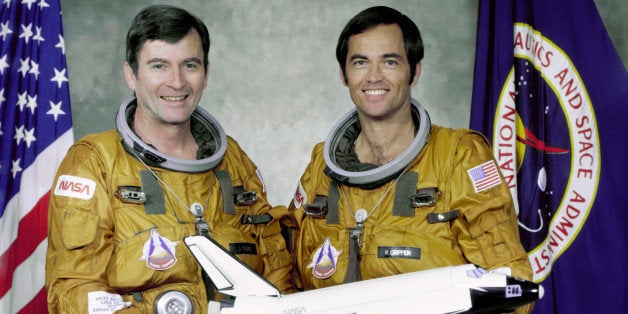
Since the end of the Space Shuttle program the questions have grown louder and louder. Many Americans I speak to, and articles covering the space program, ask, "What happened to NASA?"
Those questions are understandable because there has been an on-going debate on what NASA should do for the next major human spaceflight initiative. The debate has revolved around whether NASA should go to an asteroid, to Mars or one of its moons, or back to the Moon as a stepping stone. These, and more, are all options for "deep space" missions.
At the same time, NASA has "outsourced" the more routine low Earth orbit flights to the International Space Station to commercial companies for cargo, and relies on the Russians for crewed flights until commercial companies can take over those duties in 2017.
I'm glad to report that the rumors of NASA's demise are wrong. NASA has been focused on the longer-term. They have been working on the spacecraft and launch vehicle that will enable deep space missions, and we will see the results of those efforts in 2014. Throughout the year we will see the first test flight of the new Orion crew exploration spacecraft, and engine and booster tests on the new Space Launch System (SLS) -- the most powerful rocket ever built.
Orion is designed for the months-long and years-long missions required to reach deep space destinations. The SLS is designed to launch crews and cargo on direct trajectories that will shorten the missions to deep space destinations. To put its power into perspective, consider that the Saturn V that carried the Apollo crews to the Moon and the Space Shuttle each generated seven million pounds of thrust. The SLS will provide 10 million pounds of thrust. Furthermore, this power will deliver 3-4 times more lift capability than all current launch vehicles.
The combination of SLS and Orion will effectively establish a highway to the entire solar system. And as the Nation assesses what destinations we should explore next, the spacecraft and rocket will continue to progress through their development tests so they are ready when those decisions are made.
In addition to the growing excitement about crewed missions to deep space, SLS is also an absolute game-changer for ambitious robotic missions to the outer planets and large unprecedented astronomical observatories. Those missions will build on the discoveries of Curiosity on Mars, the Hubble Space Telescope and its successor, the James Webb Space Telescope that will replace it in 2018, and multiple robotic missions in the years ahead.
One of the challenges of robotic missions and space-based observatories is their designs have been limited by the size of existing rockets. This has constrained designers to very complex, size-limited approaches that drive up the costs of reaching for technologies that don't exist and must be developed to the nth degree.
Also, for robotic missions to the outer planets, current rockets are often forced to launch spacecraft around other planets to gain a "sling-shot boost" because they don't have enough thrust to launch directly. The effect is that those missions take 6-8 years to reach their destinations, where SLS can get them there in half that time.
As 2014 unfolds, we will all see the fruits of what NASA has been working on the last few years to develop SLS and Orion. At the same time, we should also see the early steps of a maturing "commercial space industry" as the flights to the space station pick up steam. Many will highlight those flights as the beginning of a new era in space. In fact, we have been flying to low Earth orbit since the early 1960s and it's appropriate that we outsource those routine flights to commercial companies. Longer-term I believe commercial companies will take a larger role in space, even eventually going to deep space. But they must first prove that they can handle low Earth orbit flights on a regular, sustained basis for both cargo and crew.
However, when we debate NASA's future I'll restate what President Kennedy said on May 25, 1961 when he set the goal of landing a man on the moon:
"Future generations will say that the real significance in our space program lay in the fact that it took the 'lid off' the limitations posed by the finite size and finite resources of the planet earth."
Today, NASA stands at a position that we've seen before in our history where the government must lead, and industry and the rest of our citizens benefit such as we did with the building of the railroads and the interstate highway.
Better yet, NASA has learned many lessons in the last few years to streamline the design and development of SLS and Orion to make it more affordable than past efforts of new space systems. For the early missions it is using leftover space shuttle hardware for the liquid engines and solid rocket boosters, and it also has a raft of cost-saving initiatives underway ranging from production streamlining to advanced, but cheaper, manufacturing methods for follow-on production of these next-generation space vehicles.
Incredibly, we haven't sent crews beyond low Earth orbit since the last crew walked on the Moon in 1972. With Orion and SLS, America will have the fundamental capabilities to support future missions and take the next significant steps into deep space.
So the next time you are asked what happened to NASA, you can rightfully say NASA is NOT out of business. NASA has been vigorously preparing for the future, "retooling" for the next great era of space exploration.
Bob Crippen is a former astronaut who served as pilot of first space shuttle mission (STS-1); commander of three other space shuttle missions (STS-7, STS-41C, STS-41G); and former director of the Kennedy Space Center in Florida. He is a current member of the Coalition for Space Exploration Board of Advisors.